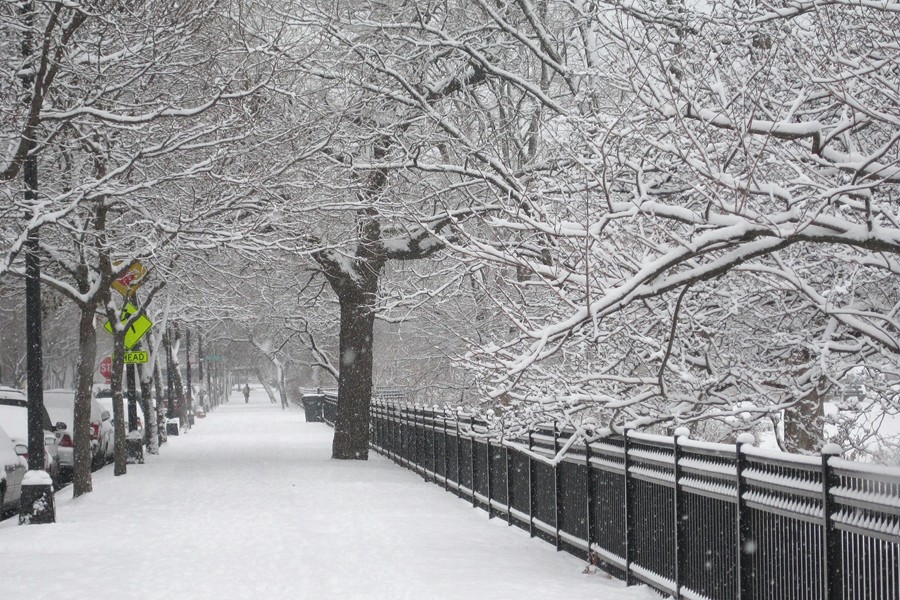I've just pushed out an interim build of the Inner Drive Technology demonstration project, Weather Now. In addition to fixing a couple of annoying bugs, I added a significant new feature. The weather lists on the home page now can show whatever text I want for the weather station names. Before, it could only show their official designations, which made the lists harder to use.
You can see how useful this is immediately. The list of NFL football games now shows you what game the weather goes with. Also, I added arbitrary sort ordering and station begin/end times, so the lists you see today may not be the same as the lists you see tomorrow.
These features take the site a half-step closer to the next major release, due at the end of January, that will allow you—yes, you—to set up your own lists. That feature set will take a while to develop, which explains why I wanted to get this half-point release out first.
Yesterday's storm, which right now has parked itself over Cape Cod, dumped 80 cm of snow on parts of New Jersey and pretty much shut down New York:
Morning commuters faced the daunting prospect of cutting fresh tracks in over a foot of snow along roads and sidewalks that looked more like Colorado than the urban north. In New York City, a badly crippled subway system hobbled along, but Long Island Rail Road service remained suspended early on Monday, as did some New Jersey Transit and Metro-North Railroad lines.
The storm’s timing was diabolical — too late for a white Christmas, but just in time to disrupt the plans of thousands of people trying to get home after the holiday, return unwanted gifts or take advantage of post-holiday bargains at stores. Public schools were not in session, much to the dismay of many children.
By 7 a.m. Monday, 50 cm covered Central Park, according to the National Weather Service. The deepest snow was recorded in Elizabeth, N.J., where 80 cm fell. By sunrise, the storm had largely moved on from New York City, heading northeast out past Long Island and up over Nantucket, gradually weakening, the weather service said.
I'm hoping friends out East will send photos. Meanwhile, here's one from the New Year's Eve storm 10 years ago, on 30 December 2000:
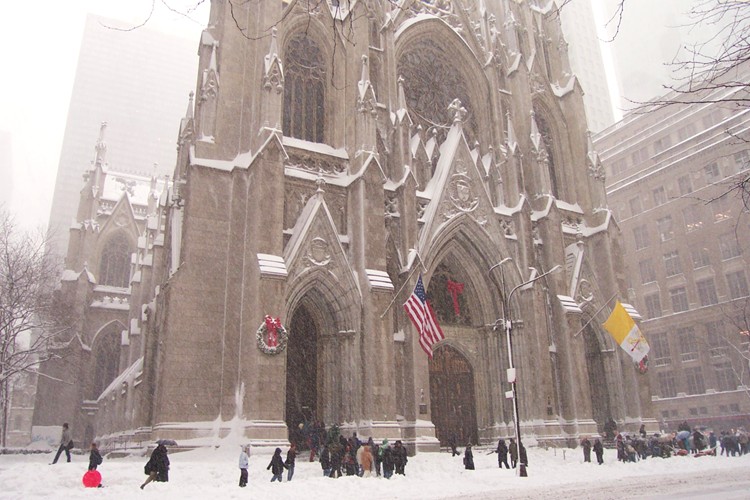
I know this will incite some regular Daily Parker readers, but we should get used to storms like this more often. They're a predicted consequence of climate change.
I can imagine that my friends in the Northeast aren't too happy today:
URGENT - WINTER WEATHER MESSAGE
NATIONAL WEATHER SERVICE NEW YORK NY
1240 PM EST SUN DEC 26 2010
...DANGEROUS WINTER STORM IMMINENT...
...BLIZZARD WARNING REMAINS IN EFFECT UNTIL 6 PM EST MONDAY...
* HAZARDS...HEAVY SNOW AND STRONG WINDS...WITH CONSIDERABLE
BLOWING AND DRIFTING OF SNOW WITH NEAR ZERO VISIBILITY AT
TIMES.
* ACCUMULATIONS...15 TO 20 INCHES...WITH LOCALLY HIGHER AMOUNTS UP
TO 2 FEET POSSIBLE.
* IMPACTS...EXTREMELY DANGEROUS TRAVEL CONDITIONS DEVELOPING
THIS AFTERNOON INTO THE EVENING DUE TO SIGNIFICANT SNOW
ACCUMULATIONS...AND STRONG WINDS CAUSING CONSIDERABLE BLOWING
AND DRIFTING OF SNOW. VISIBILITIES WILL BE NEAR ZERO AT
TIMES... WITH WHITEOUT CONDITIONS EXPECTED. STRONG WINDS MAY
ALSO DOWN SOME POWER LINES...TREE LIMBS...AND CHRISTMAS
DECORATIONS.
* TIMING...SNOW WILL BECOME HEAVY AT TIMES THIS AFTERNOON INTO
MUCH OF TONIGHT. THE SNOW WILL TAPER OFF FROM WEST TO EAST
MONDAY MORNING...BUT STRONG NORTHWEST WINDS WILL PERSIST THROUGH
THE AFTERNOON.
* WINDS....DURING THE HEIGHT OF THE STORM TONIGHT...NORTH WINDS
WILL INCREASE TO 25 TO 35 MPH WITH GUSTS OF 40 TO 60 MPH.
ISOLATED HIGHER GUSTS ARE POSSIBLE ACROSS LONG ISLAND.
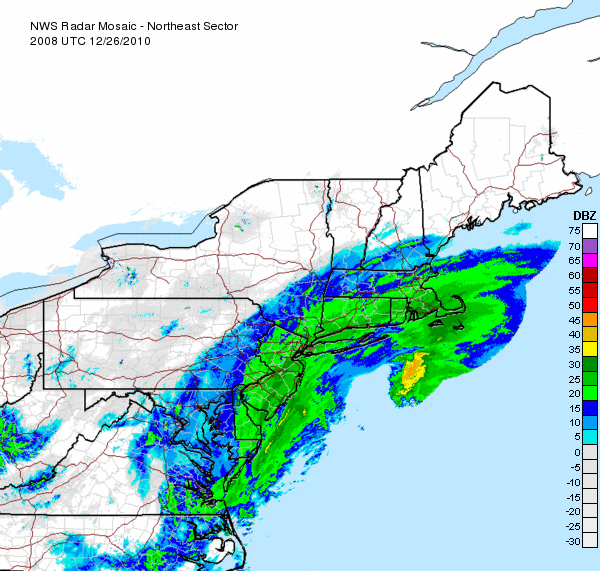
We've got a little lake-effect snow right now, with about 15 cm on the ground, but nothing too heinous. Parker, in fact, just got half an hour of running around in it at Oz Park. He's even doing better on recall. Not much better, but still.
Gulliver follows up on the 'sno-good situation at Heathrow:
Gatwick used to be owned by BAA, like Heathrow. But under its new owners, Global Infrastructure Partners, it has coped better than its London rival and is now fully operational. Part of the problem at Heathrow, of course, is that it operates at up to 98% capacity so small problems can have massive knock-on effects. But even so, the differences between snow-fighting provisions at Heathrow and Gatwick are notable, as the BBC has reported:
Earlier this year, BAA published an investment programme of £5.1bn for Heathrow over five years, of which £500,000 was invested in snow and ice-fighting technology this year, with another £3m planned for the next four years. By comparison, reports suggest that Gatwick Airport, which is half the size of Heathrow and was sold by BAA last year, spent £1m on snow and ice this year and plans to spend another £7m next year. Heathrow's "snow fleet" is made up of 69 vehicles; Gatwick's is a reported 150.
It reminds me of a statistic I encountered in 2003, when I worked for a time in Richmond, Va. That year, as many on the East Coast remember, the mid-Atlantic states had 12 snowstorms in three months. I got trapped in DC for two days in February returning from New York; I watched panicked Virginians buy all the bread and milk they could carry upon seeing the first snowflake.
Anyway, it turned out that the Commonwealth of Virginia (area: 110,785 km²) owned the same number of snowplows as the City of Chicago (area: 606 km²). It may be an unfair comparison—after all, municipalities also have snow-removal equipment—but I swear I didn't see Richmond start plowing until the snow had gotten at least 50 mm deep.
And if you want a laugh, the title of this post harks back to this old Monty Python ditty:
Back in 1979, Chicago Mayor Michael Bilandic lost re-election to Jane Byrne mostly for his failure to clear the streets of snow after the worst snowfall in the city's recorded history. His story didn't end too badly, as he ultimately became Chief Justice of Illinois; but it taught all the city's subsequent mayors to get the snowplows out before the first flake hits the ground.
The Spanish company Ferrovial—owner of the British Airports Authority, which runs Heathrow—hasn't, apparently, learned this lesson, according to Daily Beast aviation blogger Clive Irving:
[Y]ou might think that, given its importance, the ability of Heathrow not simply to wreck the holiday travel plans of hundreds of thousands of people but to undermine economies, disrupt international air cargo and, most significantly, to visit disaster on the travel industry, plans would be in place to ensure that it can function after a 13 cm snowfall. After all, terrorists would be delighted to have wrought such harm.
Here we are, though, four days after the weekend shutdown of Heathrow and even now the airport is still barely functional.
And it’s all because the people in charge of Heathrow could not muster the resources to plow two runways and clear ice and snow from terminal gates—not exactly rocket science and something hundreds of airports have to face on a regular basis in winter.
It's interesting how O'Hare manages to keep 7 runways clear (or at least the three in use at any point) during 30 cm snow events, without resorting to the army.
The earth will cast its shadow on the moon Monday night:
But on the longest night of the year, a full moon will disappear at 1:40 a.m. behind the Earth's shadow. There won't be another total lunar eclipse on the night of the winter solstice for 84 years.
Weather permitting — and the forecast isn't favorable in the Chicago area, calling for clouds building Monday and snow overnight — the eclipse will be visible everywhere in the continental United States, and at its darkest, the moon will be halfway up from the horizon in the south-southwest sky.
We'll be able to see the moon start to disappear around 12:30 am Central time, with a total eclipse from 1:40 am until 2:53 am.
Unfortunately, the weather forecast calls for snow, which in Chicago just makes everything look yellow. (Chicago uses sodium-vapor streetlights that cast banana-yellow light.) But if you're up, or you live west of here and have better weather, go out and look.
I almost forgot: the Inner Drive demonstration site, Weather Now, got a significant upgrade this weekend, to version 3.6. I added two new features that are part of long-term plan of improvements. They don't sound like much, but they're pretty important bits that other features will depend on.
First, the lists of weather stations that appear on the home page are now generated dynamically from a database table. This means that I can change them, remove them, add them, or schedule them without having to make code changes. For example, during NFL Football season, you'll notice a list of home football games that changes every Tuesday at midnight Eastern time. In the past, to add a list like that, I'd have to make code and configuration changes. Now I don't.
Now the cool part, and how this is just a step towards a larger feature: In version 3.7 (coming out in January, I hope), you, dear user, will be able to create your own lists.
Second, I've added caching to the current weather reports. Before, every page view required multiple round-trips to the weather database. Now, any time the site retrieves current weather from the database, it stores the reports for some length of time. Any subsequent page requests will find the weather reports in the cache. This means the home page loads significantly (10x) faster on most views. The site gets about 11,000 page views every day, so this is non-trivial.
The cache right now has a fixed expiration time of 180 seconds, and I can change that through the standard application configuration tools. By "fixed" I mean the cache will discard all reports older than three minutes, forcing the application to refresh those reports from the database. This strikes a good balance between current data and application speed, I think, especially since the National Weather Service (whence comes the data) has new information at about that frequency. (You can read more about how caching works in the Inner Drive Extensible Architecture™ SDK.)
I think these are really cool changes, and I'm excited about how much it moves me down the roadmap. And the 3.7 update will be even cooler.
Ah, how lovely to be at the beach in Chicago tonight. Just look at it:

Oh, just kidding. That's actually Miami Beach at sunrise in January 2007. This is what Lake Michigan looked like this evening:
The video's resolution isn't high enough to show the snowflakes proceeding in a generally horizontal fashion to the south. Nor does it show my dog, who couldn't decide whether all that snow and water was freaky or fun. (He ultimately decided the water was freaky, the snow was fun, and getting toweled off feels great.)
In Chicago, we get about 10 days a year like this against about 20 leave-work-early-it's-too-gorgeous-out days:
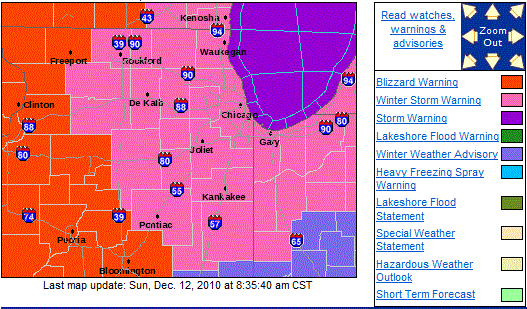
Current conditions at Inner Drive Technology World Headquarters: 1°C, winds from the north at 46 km/h gusting to
57 km/h, with snow. Oh, it gets better, according to the National Weather Service:
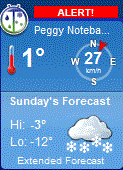 Today: Snow and areas of blowing snow. Temperature falling to around -4°C by 5pm. Very windy, with a north wind between 45 and 65 km/h, with gusts as high as 90 km/h. Chance of precipitation is 100%. Total daytime snow accumulation of 4 to 8 cm possible.
Today: Snow and areas of blowing snow. Temperature falling to around -4°C by 5pm. Very windy, with a north wind between 45 and 65 km/h, with gusts as high as 90 km/h. Chance of precipitation is 100%. Total daytime snow accumulation of 4 to 8 cm possible.
Tonight: Snow and areas of blowing snow before midnight, then areas of blowing snow and a slight chance of snow after midnight. Low around -12°C. Wind chill values as low as -22°C. Very windy, with a north northwest wind between 50 and 65 km/h, with gusts as high as 80 km/h. Chance of precipitation is 80%. New snow accumulation of less than one centimeter possible.
Again, though, I have to remind my fellow Chicagoans: for every day we get like this, we get two or three where you don't want to go back inside.
Lincoln Park, Chicago, this morning:
